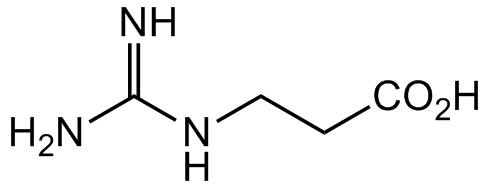3-Guanidinopropionic acid
| Code | Size | Price |
|---|
| AG-CR1-3678-M500 | 500 mg | £35.00 |
Quantity:
| AG-CR1-3678-G001 | 1 g | £50.00 |
Quantity:
Prices exclude any Taxes / VAT
Overview
Regulatory Status: RUO
Shipping:
Ambient
Storage:
-20°C
Images
Documents
Further Information
Alternate Names/Synonyms:
beta-GPA; PNU 10483; N-(Aminoiminomethyl)-beta-alanine
Appearance:
White powder.
CAS:
353-09-3
EClass:
32160000
Form (Short):
liquid
GHS Symbol:
GHS07
Handling Advice:
Keep cool and dry.Aqueous solutions should not be stored for longer than one day.
Hazards:
H315, H319, H335
InChi:
InChI=1S/C4H9N3O2/c5-4(6)7-2-1-3(8)9/h1-2H2,(H,8,9)(H4,5,6,7)
InChiKey:
KMXXSJLYVJEBHI-UHFFFAOYSA-N
Long Description:
Chemical. CAS: 353-09-3. Formula: C4H9N3O2. MW: 131.1. Synthetic. Competitive creatine uptake inhibitor. Creatine analog that alters skeletal muscle energy expenditure. Thermogenesis inhibitor. Inhibitor of energy expenditure through reduction of ATP. AMPK stimulator and PGC-1alpha activator. Reduces cellular ATP, creatine and phosphocreatine levels, consequently stimulating AMP-activated protein kinase (AMPK) and activating PPARgamma coactivator 1alpha (PGC-1alpha). Evokes a shift from glycolytic to oxidative metabolism, increased cellular glucose uptake and increased fatigue tolerance. Ameliorates hyperglycemia in animal models of non-insulin-dependent diabetes (NIDDM). Improved insulin sensitivity and promoted weight loss selectively from adipose tissue. Studied for potential use during protein refolding as an anti-aggregatory molecule similar to L-arginine.
MDL:
MFCD00045939
Molecular Formula:
C4H9N3O2
Molecular Weight:
131.1
Package Type:
Plastic Vial
Precautions:
P280, P302, P352, P304, P340, P305, P351, P338, P332, P337, P313, P405
Product Description:
Competitive creatine uptake inhibitor. Creatine analog that alters skeletal muscle energy expenditure. Thermogenesis inhibitor. Inhibitor of energy expenditure through reduction of ATP. AMPK stimulator and PGC-1alpha activator. Reduces cellular ATP, creatine and phosphocreatine levels, consequently stimulating AMP-activated protein kinase (AMPK) and activating PPARgamma coactivator 1alpha (PGC-1alpha). Evokes a shift from glycolytic to oxidative metabolism, increased cellular glucose uptake and increased fatigue tolerance. Ameliorates hyperglycemia in animal models of non-insulin-dependent diabetes (NIDDM). Improved insulin sensitivity and promoted weight loss selectively from adipose tissue. Studied for potential use during protein refolding as an anti-aggregatory molecule similar to L-arginine.
Purity:
>98%
Signal word:
Warning
SMILES:
NC(NCCC(O)=O)=N
Solubility Chemicals:
Soluble in water (50mg/ml) or other aqueous buffers (e.g. PBS).
Transportation:
Non-hazardous
UNSPSC Category:
Biochemical Reagents
UNSPSC Number:
12352200
Use & Stability:
Stable for at least 2 years after receipt when stored at -20°C. Store solutions at -20°C in the dark.
References
Energy metabolism of skeletal muscle containing cyclocreatine phosphate. Delay in onset of rigor mortis and decreased glycogenolysis in response to ischemia or epinephrine: T.M. Annesley & J.B. Walker; J. Biol. Chem. 255, 3924 (1980) | Biochemical adaptation in the skeletal muscle of rats depleted of creatine with the substrate analogue beta-guanidinopropionic acid: E.A. Shoubridge, et al.; Biochem. J. 232, 125 (1985) | Antihyperglycemic action of guanidinoalkanoic acids: 3-guanidinopropionic acid ameliorates hyperglycemia in diabetic KKAy and C57BL6Job/ob mice and increases glucose disappearance in rhesus monkeys: M.D. Meglasson, et al.; J. Pharmacol. Exp. Ther. 266, 1454 (1993) | Synthesis and biological activity of analogues of the antidiabetic/antiobesity agent 3-guanidinopropionic acid: discovery of a novel aminoguanidinoacetic acid antidiabetic agent: S.D. Larsen, et al.; J. Med. Chem. 44, 1217 (2001) | Aging-associated reductions in AMP-activated protein kinase activity and mitochondrial biogenesis: R.M. Reznick, et al.; Cell Metab. 5, 151 (2007) | Impaired PGC-1alpha function in muscle in Huntington's disease: R.K. Chaturvedi, et al.; Hum. Mol. Gen. 18, 3048 (2009) | The effect of the creatine analogue beta-guanidinopropionic acid on energy metabolism: a systematic review: I. Oudman, et al.; PLoS One 8, e52879 (2013) (Review) | Genetic depletion of adipocyte creatine metabolism inhibits diet-induced thermogenesis and drives obesity: L. Kazak, et al.; Cell Metab. 26, 660 (2017) | Creatine fuels the thermic effect of feeding: A.R. Saltiel; Cell Metab. 26, 594 (2017) (Review) | beta-GPA treatment leads to elevated basal metabolic rate and enhanced hypoxic exercise tolerance in mice: T.T. Ross, et al.; Physiol. Rep. 5, e13192 (2017)
Related Products
| Product Name | Product Code | Supplier |
|---|



